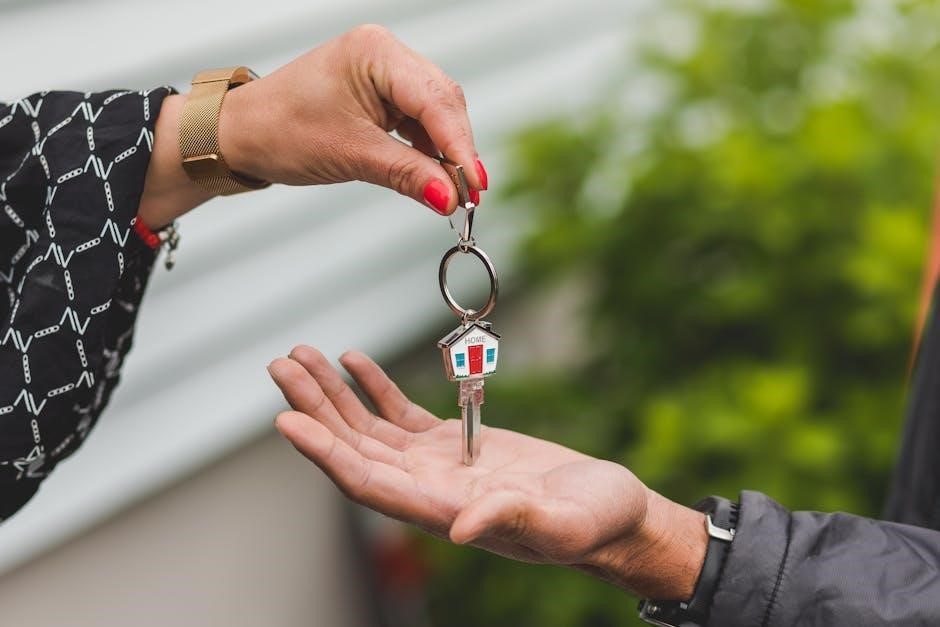A behavior contract is a written agreement between students, teachers, and caregivers, outlining expected behaviors and consequences. It promotes responsibility and accountability, serving as a proactive tool for positive behavior change. Designed to be clear and structured, it helps establish mutual understanding and collaboration, ensuring all parties are committed to achieving desired outcomes. By focusing on specific behaviors and their impact, behavior contracts provide a framework for consistent expectations and support, making them an effective intervention strategy in various settings.
- Defines clear expectations for behavior
- Outlines consequences for meeting or not meeting goals
- Encourages accountability and positive change
- Serves as a collaborative tool for all stakeholders
1.1 Definition and Purpose
A behavior contract is a written agreement between students, teachers, and caregivers that outlines specific behavioral expectations and the consequences for meeting or not meeting those expectations. Its primary purpose is to establish clear, measurable goals for behavior, ensuring accountability and consistency. By defining desired behaviors and linking them to rewards or consequences, the contract serves as a proactive tool for promoting positive behavior and reducing disruptive actions. It is often used as a Tier 2 intervention, tailored to address specific behavioral challenges, and is based on data collected about the individual’s behavior. The contract fosters a collaborative environment, encouraging students to take responsibility for their actions while providing a structured framework for support and accountability.
- Clarifies expectations for behavior
- Provides measurable goals for improvement
- Encourages accountability and responsibility
- Serves as a data-driven intervention tool
1;2 Importance of Behavior Contracts in Promoting Positive Behavior
Behavior contracts play a crucial role in promoting positive behavior by establishing clear expectations and consequences. They provide a structured framework that helps individuals understand their responsibilities and the outcomes of their actions. By outlining specific behaviors and rewards, contracts encourage accountability and motivation. This tool is particularly effective in classroom and home settings, as it fosters consistency and collaboration among students, teachers, and caregivers. Behavior contracts also help reduce disruptive actions by focusing on proactive strategies rather than reactive measures. Over time, they contribute to the development of self-regulation skills, empowering individuals to make better choices. Their effectiveness lies in their ability to create a supportive environment that encourages positive behavioral change and strengthens relationships between all parties involved.
- Encourages accountability and responsibility
- Provides clear expectations and outcomes
- Fosters consistency in behavior management
- Supports the development of self-regulation skills

Components of a Behavior Contract
A behavior contract includes expected behaviors, consequences, rewards, and signatures. It outlines clear expectations and outcomes, ensuring accountability and mutual understanding among all parties involved.
- Expected behaviors
- Consequences for meeting or not meeting expectations
- Rewards for positive behavior
- Signatures of involved parties
2.1 Expected Behaviors
Expected behaviors in a behavior contract are specific, measurable actions the individual agrees to perform. These behaviors are clearly defined and communicated to ensure understanding. They are typically positive actions that replace problem behaviors, such as completing homework, staying on task, or using respectful language. The expected behaviors are tailored to address specific issues and are established collaboratively by the student, teacher, and caregivers. For example, a student might agree to raise their hand before speaking or keep their desk organized. These expectations are monitored and form the basis for rewards or consequences, ensuring accountability and progress toward positive behavior change. By focusing on clear, achievable goals, expected behaviors provide a roadmap for success and accountability. They are essential for creating a structured and supportive environment that fosters growth and responsibility.
- Specific and measurable actions
- Clear communication of expectations
- Collaborative definition by stakeholders
- Focus on positive replacement behaviors
2.2 Consequences for Meeting or Not Meeting Expectations
Behavior contracts outline specific consequences for meeting or not meeting expected behaviors, ensuring accountability and consistency. Positive reinforcement, such as rewards or privileges, is used to encourage desired behaviors, while negative consequences, like loss of privileges, address non-compliance. These consequences must be clear, fair, and agreed upon by all parties to maintain trust and effectiveness. For example, meeting expectations might earn rewards like extra recess time, while failing to meet them could result in losing screen time. Consequences should be logically related to the behavior and implemented consistently to reinforce learning and accountability. This structured approach helps individuals understand the impact of their actions and motivates them to make positive choices. Clear consequences ensure the behavior contract remains an effective tool for fostering responsibility and achievable behavior change.
- Positive reinforcement for desired behaviors
- Clear, fair, and agreed-upon consequences
- Consistency in implementation
- Logical connection between actions and outcomes
2.3 Rewards and Reinforcements
Rewards and reinforcements are essential components of behavior contracts, motivating individuals to meet specified expectations. Positive reinforcement, such as stickers, stars, or special privileges, encourages desired behaviors. Tangible rewards, like extra recess time or small prizes, provide immediate recognition of progress. Verbal praise and acknowledgment also serve as powerful reinforcers, fostering a sense of accomplishment. Rewards should be meaningful to the individual and tied directly to the behavior being targeted. Consistency in delivering rewards is crucial to reinforce the connection between behavior and outcomes. Tailoring rewards to the individual’s preferences ensures greater effectiveness. Over time, as behaviors become consistent, rewards can gradually be phased out, replacing them with intrinsic motivators like self-satisfaction. Effective use of rewards and reinforcements enhances the overall impact of the behavior contract, promoting lasting positive change.
- Tangible rewards for immediate recognition
- Verbal praise as a powerful motivator
- Consistency in delivering reinforcement
- Meaningful rewards tailored to the individual
2.4 Signatures of Involved Parties (Student, Teacher, Caregiver)
Signatures from the student, teacher, and caregiver are essential to formalize the behavior contract, ensuring accountability and commitment from all parties. This step acknowledges mutual agreement and understanding of the expectations outlined in the contract. The student’s signature confirms their willingness to adhere to the agreed-upon behaviors, while the teacher’s signature indicates their commitment to providing support and monitoring progress. Caregivers’ signatures demonstrate their involvement in reinforcing the contract at home. Collectively, these signatures create a sense of responsibility and collaboration, fostering a supportive environment for positive behavior change. The inclusion of all stakeholders’ signatures strengthens the contract’s effectiveness, ensuring everyone is aligned and dedicated to achieving the desired outcomes.
- Formalizes the agreement between all parties
- Ensures accountability and mutual understanding
- Encourages collaboration and shared responsibility
- Strengthens the contract’s enforceability and impact

How Behavior Contracts Are Used in Schools
Behavior contracts in schools promote positive conduct through structured agreements, reinforcing good behavior and involving teachers in consistent management, fostering a disciplined and supportive learning environment.
- Clear expectations for student behavior
- Consistent consequences for actions
- Teacher-student collaboration
- Supportive learning environment
3.1 Classroom Behavior Management
Behavior contracts are valuable tools for classroom behavior management, helping teachers establish clear expectations and promote positive conduct. By outlining specific behaviors, consequences, and rewards, these contracts create a structured environment where students understand their responsibilities. Teachers can use behavior contracts to address common challenges like staying on-task, respecting peers, and following classroom rules. The contracts encourage accountability and consistency, allowing teachers to focus on instruction while maintaining order. Additionally, involving students in the creation of the contract fosters a sense of ownership and commitment to their behavior. Regular monitoring and feedback ensure the effectiveness of the contract, making it a practical solution for managing classroom behavior and supporting student success.
- Clear expectations for student behavior
- Consistent consequences for actions
- Focus on specific behavioral goals
- Encourages student accountability
- Supports a structured learning environment
3.2 School-Wide Behavior Expectations
School-wide behavior expectations are effectively implemented through behavior contracts, ensuring consistency across the entire institution. These contracts align with the school’s code of conduct, promoting a positive and respectful environment. By establishing uniform rules and consequences, behavior contracts help students understand the standards for behavior in all areas, from classrooms to hallways. They also foster a sense of community, as everyone is held to the same expectations. Schools often customize behavior contracts to address specific issues, such as respect, responsibility, and safety. This approach ensures that students, teachers, and parents are on the same page, creating a cohesive system for managing behavior and encouraging positive outcomes. Regular reviews and updates keep the contracts relevant and effective in maintaining a well-disciplined school culture.
- Uniform behavior standards across the school
- Alignment with the school’s code of conduct
- Consistent expectations for all students
- Focus on respect, responsibility, and safety
- Customizable to address specific school needs
3.3 Role of Teachers in Implementing Behavior Contracts
Teachers play a pivotal role in implementing behavior contracts, as they are often the primary facilitators of these agreements. They collaborate with students and parents to develop clear, achievable expectations and consequences. Teachers ensure the contract is tailored to the student’s specific needs, fostering a supportive learning environment. They also monitor progress, provide feedback, and reinforce positive behavior. By maintaining open communication, teachers help students understand the importance of accountability and responsibility. Their active involvement ensures the contract is consistently applied and adjusted as needed. This collaborative approach not only addresses behavioral challenges but also strengthens the teacher-student relationship, promoting academic and social growth.
- Develop and customize behavior contracts with students and parents
- Monitor and track student progress
- Provide consistent feedback and reinforcement
- Ensure clear communication of expectations
- Facilitate adjustments to the contract as needed

Behavior Contracts for Home Use
Behavior contracts for home use involve families in promoting positive behavior through clear expectations and consequences. Parents and children collaborate to establish rules, fostering accountability and responsibility.
- Encourage family participation in behavior management
- Define specific behaviors and rewards
- Provide a structured framework for discipline
- Strengthen parent-child communication
4.1 Family Behavior Contracts
Family behavior contracts are agreements designed to address specific behavioral issues within the home. They involve parents and children collaboratively setting clear expectations and consequences, fostering accountability and responsibility. These contracts often include daily goals, such as completing homework or maintaining respectful communication, with rewards for adherence and consequences for non-compliance. By involving all family members, these contracts promote a supportive environment and encourage positive behavior. They are particularly effective for addressing issues like sibling rivalry, chores, and screen time. Parents can use printable templates to create customized contracts, ensuring the agreement is tailored to their child’s needs and developmental stage. Regular review and feedback sessions help maintain effectiveness and adapt to changing circumstances, ensuring long-term success in behavior modification.
4.2 Addressing Specific Behavioral Issues at Home
Family behavior contracts are effective tools for addressing specific behavioral issues at home, such as disrespect, incomplete chores, or excessive screen time. These contracts outline clear expectations, consequences, and rewards, helping to establish accountability. Parents and children collaborate to identify target behaviors and develop strategies for improvement. For example, a contract might focus on reducing arguments or improving homework completion rates. Rewards, such as extra privileges or fun activities, motivate positive behavior, while consequences, like losing screen time, encourage adherence. By addressing specific issues, these contracts provide a structured approach to behavior modification, fostering a supportive home environment. Regular reviews allow families to track progress and adjust the contract as needed, ensuring long-term success in overcoming behavioral challenges.
- Identify specific behavioral goals
- Develop clear rewards and consequences
- Encourage collaboration and accountability
- Monitor progress and adapt as needed

Creating a Behavior Contract Using PDF Templates
Behavior contract PDF templates simplify the creation process, offering pre-designed sections for expectations, consequences, and rewards. They are customizable, ensuring contracts are tailored to individual needs efficiently.
5.1 Overview of Available Templates
Behavior contract PDF templates are pre-designed documents that provide a structured framework for creating behavior contracts. They are available in various formats, including PDF, Word, and Excel, and are customizable to suit specific needs. These templates typically include sections for expected behaviors, consequences, rewards, and signatures of involved parties. They are versatile and can be used in schools, homes, or healthcare settings. Many templates are free to download and offer features like smiley face icons, daily behavior goal setting, and comment sections for detailed feedback. Some templates are specifically designed for classroom behavior management, while others focus on addressing specific behavioral issues at home. They are user-friendly and help ensure consistency in expectations and accountability. Using a template saves time and ensures all essential elements of a behavior contract are included. They are ideal for educators, parents, and healthcare providers seeking to promote positive behavior changes effectively.
- Available in PDF, Word, and Excel formats
- Customizable to meet individual needs
- Includes sections for behaviors, consequences, rewards, and signatures
- Versatile for use in schools, homes, or healthcare settings
- Free to download and user-friendly
5.2 Steps to Customize a Behavior Contract Template
Customizing a behavior contract template involves several straightforward steps to tailor it to specific needs. First, identify the target behavior(s) and define clear, measurable goals. Next, specify the criteria for meeting expectations, such as frequency or duration of the desired behavior. Outline the consequences for not meeting expectations and the rewards for achieving them. Ensure the language is positive and easy to understand. Collaborate with stakeholders, such as students, teachers, or parents, to gain buy-in and ensure relevance. Include sections for signatures to formalize the agreement. Finally, review and revise the contract as needed to reflect progress or changing needs. Saving the customized template in PDF format ensures it is easily shareable and maintainable.
- Identify and define target behaviors
- Set clear, measurable criteria
- Outline consequences and rewards
- Collaborate with stakeholders
- Include signature sections
- Review and revise as needed
5.3 Benefits of Using Editable PDF Formats
Editable PDF formats offer numerous advantages for creating and managing behavior contracts. They allow users to easily customize templates to suit specific needs, ensuring the contract aligns with individual or organizational goals. PDFs maintain a professional and consistent layout, which is essential for formal documents. They can be quickly shared via email or downloaded, making distribution convenient. Additionally, editable PDFs can be saved and printed, providing a hard copy when required. The ability to password-protect PDFs enhances security, safeguarding sensitive information. Overall, editable PDFs are versatile, efficient, and practical for creating tailored behavior contracts that meet diverse requirements while maintaining a professional appearance.
- Customizable to meet specific needs
- Maintains a professional and consistent layout
- Easy to share and distribute
- Can be saved and printed
- Enhanced security with password protection

Implementation and Monitoring of Behavior Contracts
Implementation involves collaboration between students, teachers, and caregivers, with regular monitoring and feedback to ensure consistency and track progress toward behavioral goals effectively, fostering accountability.

- Collaboration among stakeholders
- Regular monitoring of behavior
- Constructive feedback provided
- Consistency in expectations
- Progress tracking
- Fostering accountability

6.1 Developing the Contract with Stakeholders
Developing a behavior contract with stakeholders involves collaboration between students, teachers, and caregivers to establish clear, mutual goals and expectations. This process ensures that all parties understand their roles and responsibilities, fostering a sense of ownership and accountability. Stakeholders work together to define specific behaviors, consequences, and rewards, ensuring the contract is realistic and achievable. Open communication is key to addressing concerns and gaining buy-in from everyone involved. By involving stakeholders in the development process, the contract becomes a tool for building trust and promoting positive relationships. This collaborative approach also helps to identify potential challenges and develop strategies to overcome them, ensuring the contract is effective and sustainable. Regular discussions and feedback sessions are essential to refine the agreement and maintain its relevance over time.
- Collaboration between students, teachers, and caregivers
- Clear definition of roles and responsibilities
- Mutual agreement on expectations and goals
- Open communication to address concerns
- Building trust and accountability
- Regular feedback and refinement
6.2 Monitoring Progress and Providing Feedback
Monitoring progress and providing feedback are essential steps in ensuring the effectiveness of a behavior contract. Regular check-ins with the student help track their behavior and identify areas for improvement. Using tools like behavior charts or progress reports can make this process systematic and transparent. Feedback should be constructive, focusing on specific behaviors rather than general criticism. Positive reinforcement for achieved goals motivates the student to continue improving. Parents and caregivers should also be involved in this process to maintain consistency across settings. Regular communication between all parties ensures the contract remains relevant and effective. Adjustments to the contract can be made based on feedback to better support the student’s progress. This ongoing monitoring and feedback loop help sustain positive behavior changes over time.
- Regular check-ins to track behavior
- Use of behavior charts or progress reports
- Constructive feedback focused on specific behaviors
- Positive reinforcement for achieved goals
- Consistency across home and school settings
- Adjustments based on feedback
6.3 Reviewing and Updating the Contract
Regularly reviewing and updating the behavior contract ensures it remains relevant and effective. This process involves assessing the student’s progress, gathering feedback from all parties, and making necessary adjustments. The contract should be reviewed at specific intervals, such as weekly or monthly, to evaluate whether the expected behaviors are being met. If the student has consistently met the goals, the contract may need to be updated with more challenging expectations. Conversely, if the student is struggling, the contract can be modified to provide additional support or alter the consequences and rewards. Documentation of these changes is essential to maintain clarity and ensure all stakeholders are informed. This collaborative approach fosters adaptability and ensures the contract continues to support the student’s growth and behavior improvement.
- Regular reviews to assess progress
- Feedback from students, teachers, and caregivers
- Adjustments to expectations or consequences
- Documentation of changes
- Collaborative approach for adaptability

Effectiveness of Behavior Contracts
Behavior contracts are proven to be effective tools for promoting positive behavior and accountability. They enhance consistency, motivation, and responsibility, leading to measurable improvements in behavior over time.
- Proven to enhance accountability and responsibility
- Encourage consistent and positive behavior
- Lead to measurable behavior improvements
- Support long-term behavior change
7.1 Research Supporting the Use of Behavior Contracts
Research consistently demonstrates the effectiveness of behavior contracts in promoting positive behavior change. Studies indicate that these contracts enhance accountability, improve student engagement, and reduce disruptive behaviors. By providing clear expectations and consequences, behavior contracts create a structured environment that fosters better decision-making. Additionally, they strengthen the teacher-student and parent-student relationship by encouraging collaboration and mutual understanding. The use of behavior contracts has been shown to lead to significant improvements in academic performance and social skills. Furthermore, they serve as a valuable tool for addressing specific behavioral challenges, making them a widely recommended intervention in educational and home settings. Their effectiveness is well-documented, with positive outcomes observed across various age groups and behavioral issues.
7.2 Success Stories and Case Studies
Success stories and case studies highlight the practical effectiveness of behavior contracts in real-world settings. For instance, a classroom behavior contract helped a student named John improve his focus and reduce disruptions, leading to better academic performance. Similarly, a family behavior contract addressing screen time resulted in a child spending more time on homework and physical activities. These examples demonstrate how behavior contracts foster accountability and positive change. Teachers and parents often report improved relationships and reduced conflict when using these contracts. Case studies also show that behavior contracts are adaptable, working effectively for students with diverse needs and behaviors. By providing clear expectations and consequences, they empower individuals to take charge of their actions, leading to lasting behavioral improvements and stronger interpersonal connections.
- Classroom behavior contracts improved student focus and performance.
- Family contracts reduced screen time and increased productive activities.
- Contracts strengthened relationships between teachers, students, and parents.
- Adaptability of contracts ensured effectiveness across diverse needs.

Examples and Templates
Behavior contract templates are widely available in formats like PDF and Word, offering customizable solutions for schools and homes. These templates include sections for expected behaviors, consequences, and rewards, making it easy to create personalized agreements tailored to specific needs. Examples range from classroom behavior contracts to family behavior charts, providing clear frameworks for promoting positive behavior. Users can download and edit these templates to suit individual or organizational requirements, ensuring effective implementation and tracking of behavioral goals. Printable templates are particularly popular for their convenience and accessibility, allowing quick setup and distribution in various settings.
- Classroom behavior contract templates for school use.
- Family behavior charts and agreements for home use.
- Editable PDF and Word formats for customization.
- Printable templates for easy distribution and implementation.
8.1 Sample Behavior Contract for the Classroom
A sample behavior contract for the classroom is a structured agreement outlining expectations for student behavior. It typically includes sections for expected behaviors, consequences for not meeting expectations, and rewards for positive actions. For example, a contract might specify staying on task during lessons, raising hands to speak, and respecting peers. Consequences could include verbal reminders or loss of privileges, while rewards might involve stickers, stars, or special activities. The contract is often co-created with the student and teacher, ensuring understanding and commitment. Printable templates are available online, offering customizable options to suit individual classroom needs. Teachers can use these contracts to promote accountability and foster a positive learning environment, helping students develop self-regulation skills and responsibility for their actions. Regular reviews allow for adjustments based on progress and feedback.
- Specifies clear behavioral expectations
- Includes consequences and rewards
- Customizable for individual needs
- Encourages student accountability
8.2 Printable Behavior Contract Templates for Home
A sample behavior contract for the classroom is a structured agreement outlining expectations for student behavior. It typically includes sections for expected behaviors, consequences for not meeting expectations, and rewards for positive actions. For example, a contract might specify staying on task during lessons, raising hands to speak, and respecting peers. Consequences could include verbal reminders or loss of privileges, while rewards might involve stickers, stars, or special activities. The contract is often co-created with the student and teacher, ensuring understanding and commitment. Printable templates are available online, offering customizable options to suit individual classroom needs. Teachers can use these contracts to promote accountability and foster a positive learning environment, helping students develop self-regulation skills and responsibility for their actions. Regular reviews allow for adjustments based on progress and feedback.
- Specifies clear behavioral expectations
- Includes consequences and rewards
- Customizable for individual needs
- Encourages student accountability
8.3 Behavior Contracts for Specific Behaviors
Behavior contracts for specific behaviors are tailored to address particular actions or habits that need improvement. These contracts are designed to target individual behaviors, such as staying on task, reducing disruptions, or addressing violent outbursts. They are customizable to focus on the exact behavior needing change, making them highly adaptable for different situations. For instance, a contract might focus on reducing interruptions during lessons or improving respectful communication at home. By concentrating on specific behaviors, these contracts provide clear guidelines and consequences, helping individuals understand expectations and work toward improvement. They often include rewards for positive actions, encouraging motivation and accountability. This targeted approach ensures that efforts are directed effectively, leading to measurable progress and lasting behavior change.
- Targets specific behaviors needing improvement
- Customizable for individual or situational needs
- Includes clear expectations and consequences
- Encourages accountability and positive change
Behavior contracts are effective tools for promoting positive behavior, offering structured agreements that foster accountability and responsibility. Their adaptability to various settings makes them invaluable for fostering positive change.
9.1 Summary of Key Points
A behavior contract is a structured agreement outlining expectations, consequences, and rewards to promote positive behavior. It involves collaboration between students, teachers, and caregivers, ensuring accountability and mutual understanding. Key elements include defined behaviors, measurable goals, and clear outcomes. Effective implementation requires consistent monitoring, feedback, and adjustments based on progress. Behavior contracts are versatile, applicable in schools and homes, and supported by research as an effective behavioral intervention. They foster responsibility, improve relationships, and provide a framework for sustainable behavior change. By focusing on specific actions and their impact, these contracts empower individuals to take ownership of their behavior, leading to lasting positive outcomes.
- Structured agreement with clear expectations
- Involves collaboration among stakeholders
- Includes measurable goals and outcomes
- Requires consistent monitoring and feedback
- Supported by research as an effective tool
- Applicable in various settings
9.2 Encouragement to Implement Behavior Contracts
Implementing behavior contracts is a proactive and effective way to foster positive behavior in various settings. These contracts provide clarity, accountability, and a collaborative approach to addressing behavioral challenges. By outlining clear expectations and consequences, they empower individuals to take ownership of their actions. Behavior contracts also strengthen relationships between students, teachers, and caregivers, creating a supportive environment for growth. Their versatility makes them suitable for both classroom and home use, addressing specific behaviors and promoting lasting change. With research backing their effectiveness, behavior contracts are a valuable tool for educators and parents seeking to encourage responsibility and resilience. Embrace this structured approach to help individuals thrive and achieve their full potential.
- Foster accountability and responsibility
- Provide clear expectations and consequences
- Strengthen relationships between stakeholders
- Encourage positive and lasting behavior change
- Supported by research and proven effectiveness